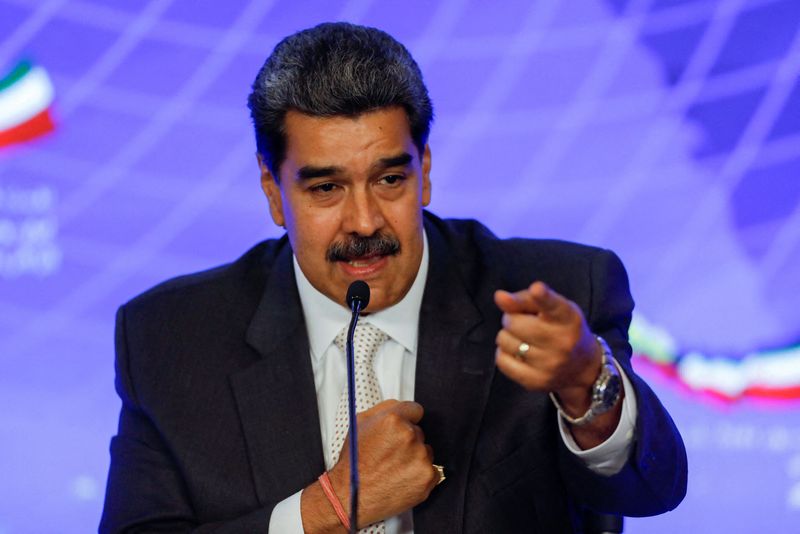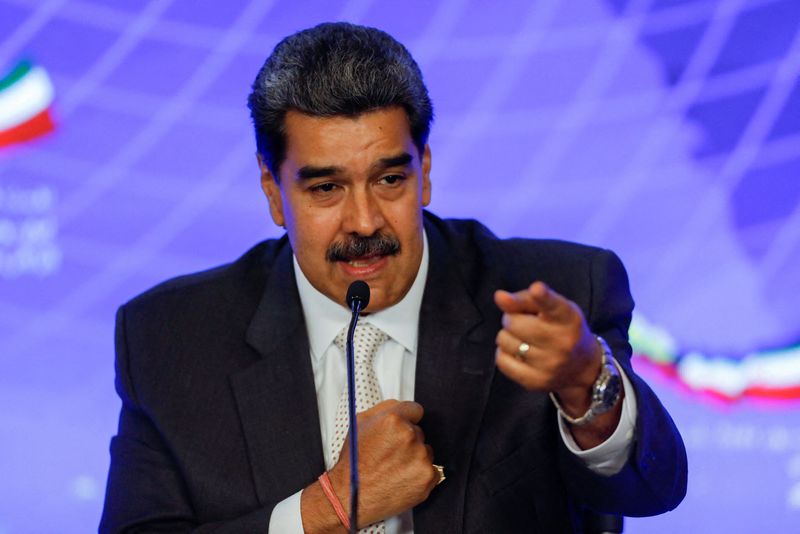Commodities
US broadly eases Venezuela oil sanctions after election deal


© Reuters. FILE PHOTO: Venezuela’s President Nicolas Maduro speaks during a meeting with Iranian President Ebrahim Raisi at the Miraflores Palace, in Caracas, Venezuela June 12, 2023. REUTERS/Leonardo Fernandez Viloria/File Photo
By Matt Spetalnick and Marianna Parraga
WASHINGTON (Reuters) – The Biden administration on Wednesday broadly eased sanctions on Venezuela’s oil sector in response to a deal reached between the government and opposition parties for the 2024 election – the most extensive rollback of Trump-era restrictions on Caracas.
A new general license issued by the U.S. Treasury Department authorized OPEC member Venezuela, which had been under crushing sanctions since 2019, to produce and export oil to its chosen markets for the next six months without limitation.
U.S. Secretary of State Antony Blinken welcomed President Nicolas Maduro’s electoral concessions but said Washington has given him until the end of November to begin lifting bans on opposition presidential candidates and start releasing political prisoners and “wrongfully detained” Americans.
A senior State Department official, speaking to Reuters on condition of anonymity, threatened to reverse sanctions relief measures unless Maduro takes such action.
The U.S. moves follow months of negotiations in which Washington had pressed Caracas for concrete actions toward democratic elections in return for lifting some – but not all – of the tough sanctions imposed under former U.S. President Donald Trump.
It also represents a significant step in the increased engagement of President Joe Biden’s administration with Maduro on issues ranging from energy to migration, a shift from Trump’s “maximum pressure” campaign against the socialist government.
Venezuela ruling party official Jorge Rodriguez, who leads the government’s negotiating team at talks with the opposition, said on state television later on Wednesday that the sanctions relief affected all oil activities.
“The possibility of any person or company coming to Venezuela to invest is totally open,” he said.
Maduro’s government and the opposition reached an agreement in Barbados on Tuesday on electoral guarantees for an internationally monitored vote to be held in the second half of 2024. But the deal stopped short of Maduro agreeing to reinstate opposition candidates who had been barred from public office.
Blinken said in a statement that the U.S. was acting “consistent with our longstanding commitment to provide U.S. sanctions relief in response to concrete steps toward competitive elections and respect for human rights and fundamental freedoms.”
Wednesday’s announcements alleviated some of the toughest sanctions that Venezuela has faced but it left in place a number of other restrictions.
Even so, the U.S. measures could reopen Venezuela’s doors to dozens of oil companies with frozen or reduced operations in Venezuela.
The U.S. imposed harsh sanctions on Venezuela to punish Maduro’s government following his 2018 re-election, which the U.S. and other Western governments rejected as a sham. Since 2019, U.S. sanctions have banned state-run oil company PDVSA from exporting to its chosen markets.
TROUBLED VENEZUELAN OIL SECTOR
The changes announced on Wednesday include the issuance of a six-month general license allowing the production, sale and export of Venezuela’s crude and gas, without limitations on customers or destinations, and another general license authorizing dealings with Minerven – the Venezuelan state-owned gold mining company.
The U.S. Treasury Department said in a statement, however, that it was prepared to revoke those authorizations at any time if representatives of Maduro fail to follow through on their commitments in the deal with the opposition.
Treasury also removed the secondary trading ban on certain Venezuelan sovereign bonds and state-run oil company PDVSA debt and equity, though a ban on trading in the primary Venezuelan bond market remains in place, it said.
The U.S. has been seeking ways to boost global flows of oil to alleviate high prices caused by sanctions on Russia and OPEC+ decisions to reduce output.
But the chances Venezuela’s exports could offset those cuts are slim absent a big increase in investment in the country’s crippled oil sector, oil industry experts said.
Two decades of mismanagement and insufficient investment, coupled with U.S. oil sanctions since 2019, are expected to stymie state-run PDVSA’s ability to make a quick comeback to cash-paying oil markets and offer its crude at fair prices.
Talks between the government and the opposition, meant to provide a way out of Venezuela’s long-running political and economic crisis, were held on Tuesday for the first time in nearly a year. They agreed to further meetings at an unspecified date.
The deal they announced said each side can choose its 2024 candidate according to its internal rules but did not reverse bans on some opposition figures – including Oct. 22 primary frontrunner Maria Corina Machado – that prevent them from holding office.
Opposition sources said they have not given up on trying to get those bans lifted.
Commodities
Oil prices rise; U.S. crude inventories plunge, Russia-Ukraine truce eyed
Commodities
India’s Reliance to stop buying Venezuelan oil over US tariffs, sources say
Commodities
Oil prices climb on Venezuela supply worries

 Forex3 years ago
Forex3 years agoForex Today: the dollar is gaining strength amid gloomy sentiment at the start of the Fed’s week

 Forex3 years ago
Forex3 years agoUnbiased review of Pocket Option broker

 Forex3 years ago
Forex3 years agoDollar to pound sterling exchange rate today: Pound plummeted to its lowest since 1985

 Forex3 years ago
Forex3 years agoHow is the Australian dollar doing today?

 Cryptocurrency3 years ago
Cryptocurrency3 years agoWhat happened in the crypto market – current events today

 World3 years ago
World3 years agoWhy are modern video games an art form?

 Commodities3 years ago
Commodities3 years agoCopper continues to fall in price on expectations of lower demand in China

 Economy3 years ago
Economy3 years agoCrude oil tankers double in price due to EU anti-Russian sanctions



























